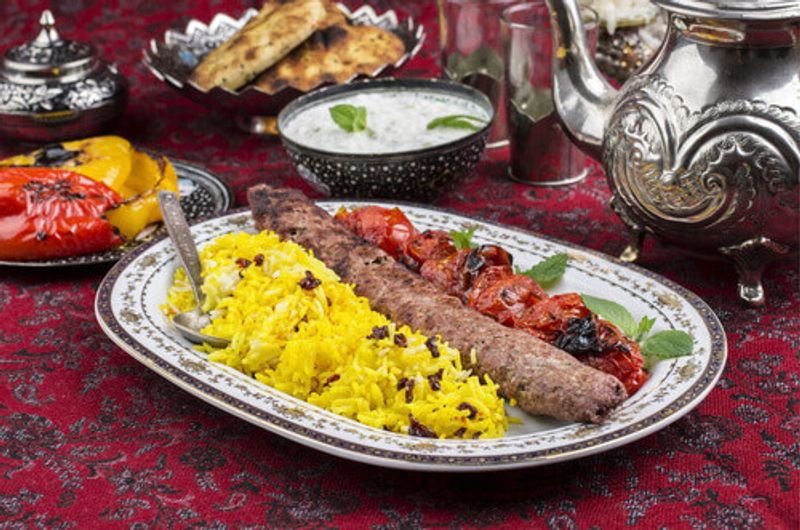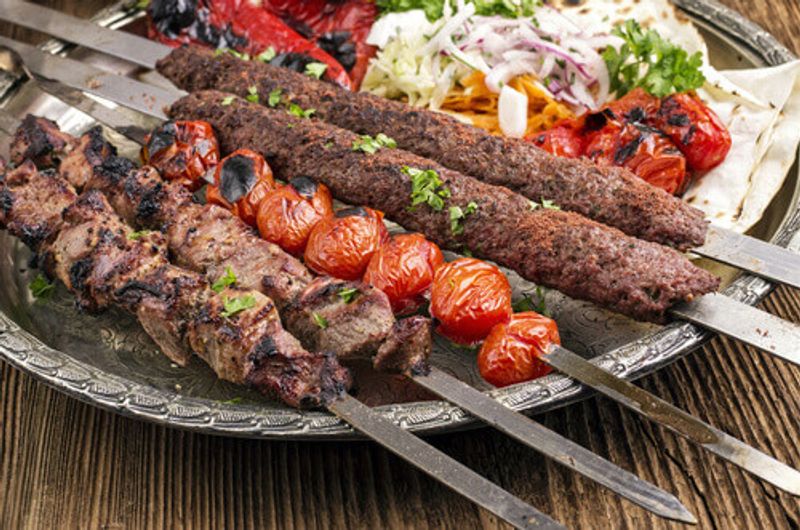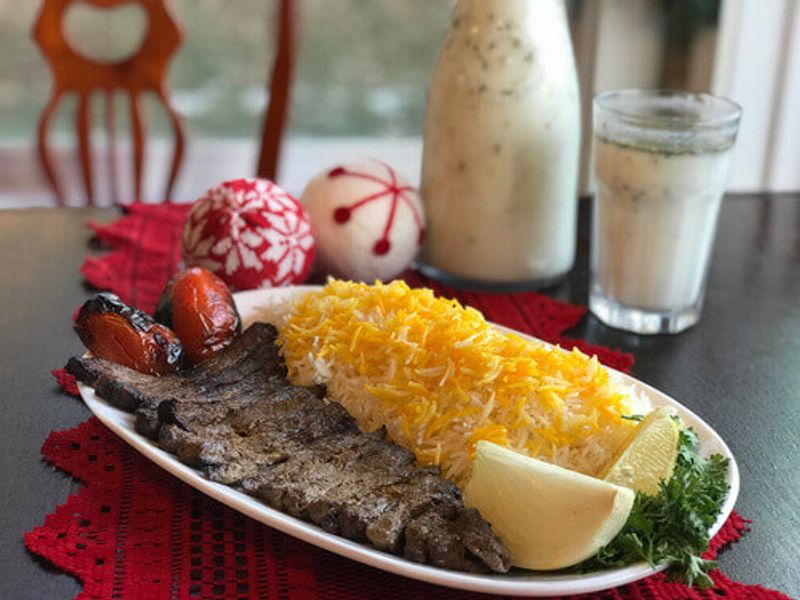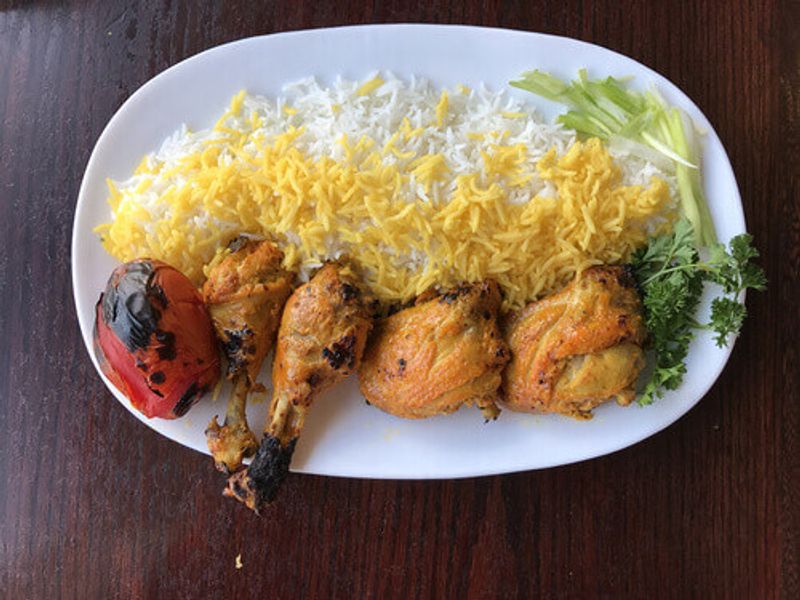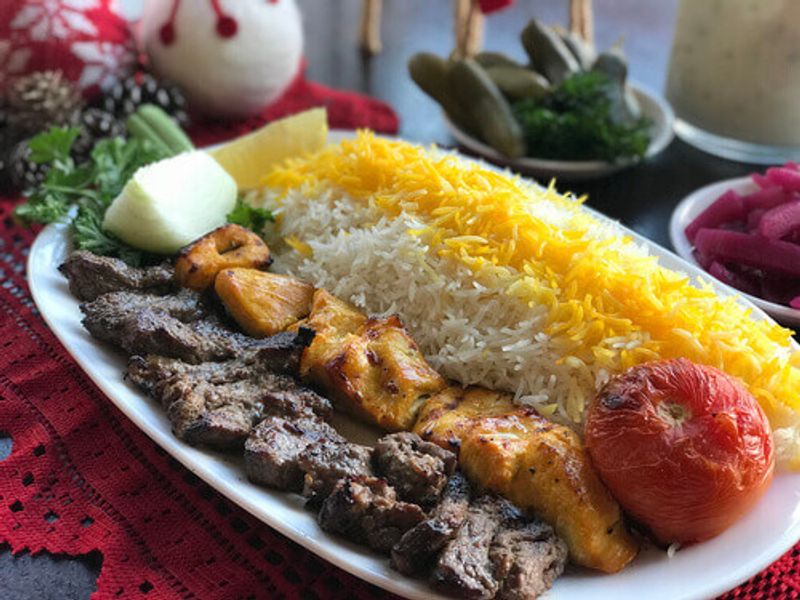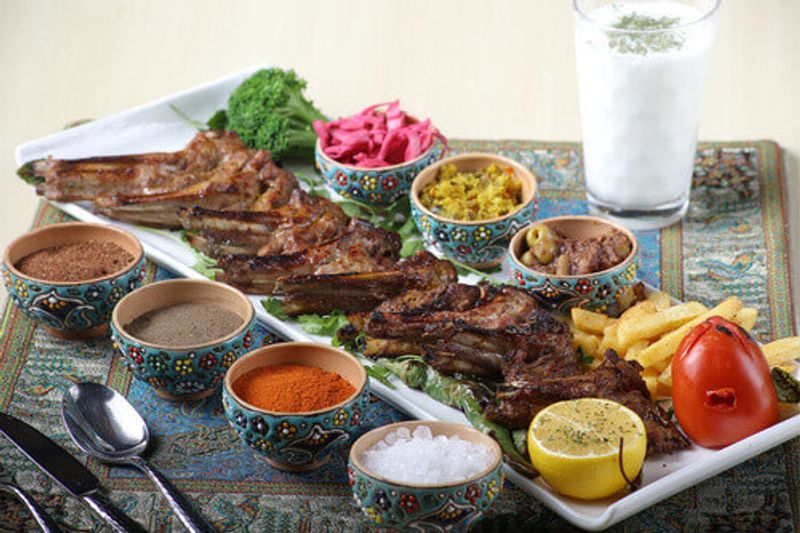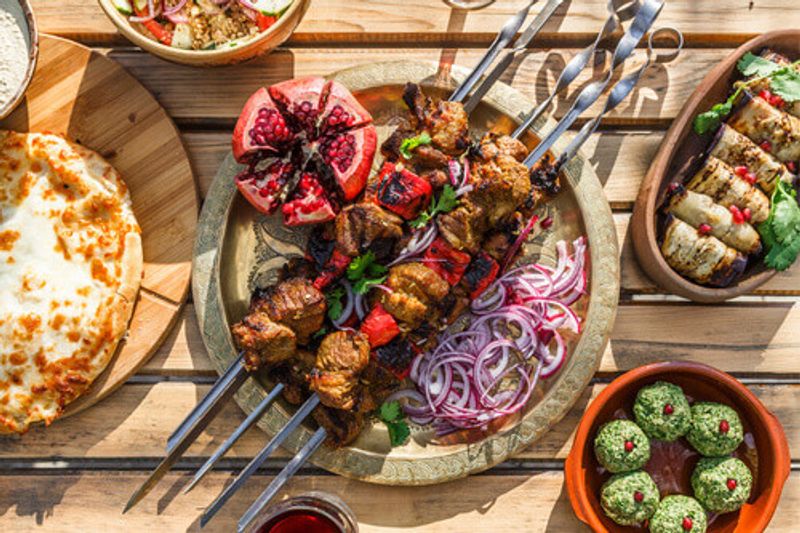Iran’s national dish, the kebab, comes in all types, sizes, and flavours. We’ve picked out the best, and where to try them across Iran
The humble kebab – skewered chunks of marinated meat, grilled or roasted over hot coals – has been cooked in Iran for centuries and has become the country’s national dish. Persian kebabs come in all varieties and are often made by wrapping patties of minced lamb or beef around a skewer. Sometimes they are just unadulterated chunks of marinated meat or chicken threaded onto a spike and barbecued. Marinating, shaping and cooking the humble kebab has become an art form in cities from Shiraz to Tabriz. Most kebabs come with a side of grilled tomato (scoop out the flesh and leave the skins) and raw shallots or onions, and served with minted yoghurt. Wash it all down with a doogh – a minty yoghurt and sparkling water drink.
Chelo at Haj Ali Chelo Kebab, Tabriz
It is said that it was because of the Persian Qajar King, Naser al-Din Shah’s love for the chelo kebab that it became Iran’s national dish. For centuries, various types of meats have been marinated and the grilled on a skewer and served with rice. Chelo (basmati rice) is how most kebabs are served in Iran with 'chelo kebab' being the catch all term. Whether its grilled lamb, beef or chicken, when ordering a chelo, the meat will come served nestled atop a pile of buttery rice infused with saffron and sumac (a red spice) and served with grilled tomatoes. The stunning 15th-century covered Tabriz Bazaar is not only home to stalls selling all kinds of antiques, spices and carpets but also it is home to Haj Ali Chelo Kebab – one of the most historic kebab houses in Tabriz. The décor might be basic but it serves arguably the best chelo kebabs in the country, thanks to the delicious locally produced butter that is melted into the saffron rice.
Kubideh at Shamshiri, Tehran
Kubideh is the most traditional of Iranian kebabs and is made by wrapping (by hand) minced beef or lamb around skewers. The texture has to be the right mix of fatty meat for juiciness, spices for flavour, and chopped onion for texture to ensure the meat doesn’t dry out or slip off the skewer when cooking. Kubideh is usually served with two skewers of the wrapped juicy meat so plenty enough to share. One of the oldest restaurants in Tehran is Shamshiri (southeast corner of Sabzeh Meydan, Panzdah-eh Khordad Street) near the south-east entrance to the Grand Bazaar. Expect it to be packed at lunch time with local shop owners tucking in alongside ravenous tourists, but if you are lucky enough to get a seat you’ll find the best kubideh in town.
Barg at Sharzeh, Shiraz
Rather than minced meat the barg uses delicious beef sirloin or lamb fillets that have been marinating in oil and onions. Unlike the minced kubideh the barg doesn’t have juices that dribble down your chin but instead the perfectly cooked meat, served on a single skewer, will melt in your mouth. Arguably the best kebab restaurant in this ancient city, Sharzeh (Vakil Street, Shiraz) is found right by the city’s bustling Bazar-e-Vakil (Vakil Bazaar). Persian music wafts through the air, mingling with the smells of roasting meats as a raucous crowd of traders, shoppers and tourists tuck into kebabs over the two floors. This hidden gem serves the best barg of anywhere in Iran – lumps of delicious lamb, slowly marinated in lime juice with onions and garlic.
Joojeh at the Shahrzad, Isfahan
For those looking for something lighter, try the joojeh (grilled saffron chicken kebab). Marinated in oil, many locals prefer it to be served on the bone, which they think brings out more flavour from the chicken. However, many places will have on- or off-the-bone options.
Try the joojeh at the Shahrzad Restaurant (Abbas Abad Street, Isfahan). This popular restaurant with stained-glass windows and impressive mirror and tile work, fits right into the Qajar style of architecture found throughout the city. This lively, bustling restaurant has a fantastic atmosphere and does an exceptionally good joojeh, as well as having a good vegetarian selection.
Bakhtiari at the Alborz, Tehran
The bakhtiari is essentially a mix of the kubideh and the joojeh. One chunk of chicken followed by one chunk of minced meat. The melting juice of the fatty meat, keep the chicken deliciously moist and is a great way to try two different dishes at the same time.
The Alborz (North Sohrevardi Street, Tehran) is one of Tehran’s most exclusive restaurants, serving excellent kebabs of all kinds and the bakhtiari is exceptional here. But come here to watch how the capital’s glitterati live, eat and socialise. This hot spot is where the city’s celebrities will come to enjoy not only the fine kebabs but the wide range of deserts, too.
Shishlik at the Shayan, Shandiz
Famous world over, the shashlik is just delicious chunks of lamb or beef on the bone served with rice. The meat may well be beef ribs or lamb chops marinated in spices and oil and cooked with the bone to give it a deep flavour. The shashlik comes from the town of Shandiz near the holy city of Mashhad. For visitors in the area head to Shayan (Shandiz Square, Shandiz Town, Mashhad), the original home of the shashlik where you can tuck into your meat in the shady garden or eat from the comfort of a traditional carpeted bed. There are tables available too if you’re feeling less adventurous.
Torsh at the Mahtab Traditional Restaurant, Lahijan
The kebab torsh, or sour kebab, is luxurious chunks of sirloin beef or juicy chicken marinated in a rich sauces made up of garlic, parsley, oil, pomegranate paste and walnuts. Its tangy flavour gives the sour title but don’t let that put you off. This dish is a speciality of the coastal Gilan province, just outside Tehran and Mahtab Traditional Restaurant (Golestan Square, Lahijan) does it exceptionally well. Large portions all accompanied by bread, baked fresh on the premises. The restaurant is also something of a museum to the region’s culture with the restaurant built in Gilan style and staff wearing traditional Gilan dress serve the local delicacies whilst traditional live music keeps guests entertained.
